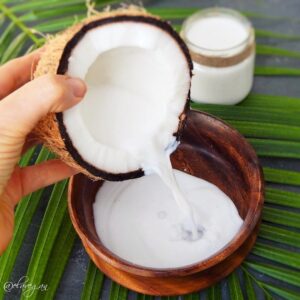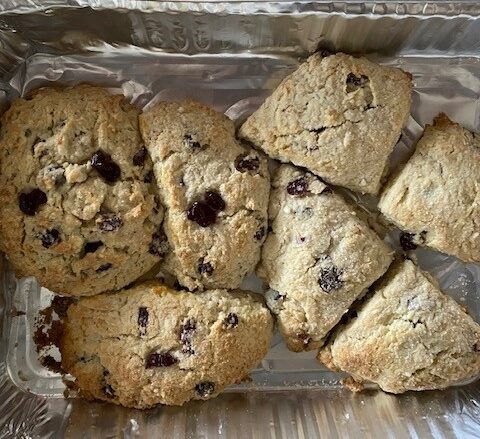
Ela Vegan / Michaela Vais
—————————————————————————————————————————
The edible fruit of the coconut palm is one the most versatile and widely used natural products and is a very important ingredient in tropical regions, being used in dishes to create curry, rice, and Haupia. The endosperm tissue (coconut flesh and coconut water) is the edible part of the coconut. Coconut water is the aqueous part of the coconut endosperm whereas coconut flesh is the solid part. Coconut meat is high in fat and can be dried, eaten fresh, or processed into coconut milk or coconut oil. It is used mainly as an ingredient in many food recipes; Coconut water is mainly used as a refreshing beverage. Coconut milk refers to the aqueous extract obtained by grating the solid coconut endosperm, sometimes with the addition of water. This too is enjoyed as a beverage or as a creamer for coffee.
The recipe below is a modified version of Natilla Colombiana. It replaces cow’s milk with plant-based coconut milk creating a vegan-friendly dessert without sacrificing taste or tradition. If you’re looking for another coconut dessert, add this one to your recipe box!
Modified Recipe
The process and other ingredients are the exact same as the original recipe. The only change made is the type of milk being used.
- 4 ½ cups (1080 ml or a little bit more than a liter) of coconut milk (divided)
- ¼ cup (50 g) white sugar
- ½ cup (107 g) packed brown sugar
- 1 dash ground cloves (optional)
- 4 cinnamon sticks
- ¾ cup (45 g) shredded coconut (optional), I use sweetened shredded coconut
- 1 cup (120 g) cornstarch
- 1 tbs cinnamon powder (for decoration)
- Pour 3½ cups (840 ml) of coconut milk into a big pot. Then add white sugar, brown sugar, cloves, and cinnamon sticks. Stir all ingredients with a wooden spoon and bring coconut milk to a boil over medium-low heat.
- As soon as the coconut milk comes to a boil, remove it from the stove and let it rest for about 5 minutes.
- In the meantime, mix the cornstarch with the remaining cup (240 ml) of coconut milk until it completely dissolves.
- Once the 5 minutes have passed, put the pot back on the stove over medium-low heat. Remove the cinnamon sticks and add the shredded coconut. Then pour the dissolved cornstarch into the hot coconut milk. Stir constantly with a wooden spoon until it thickens and you can see the bottom of the pot.
- Pour immediately into a serving dish or casserole and let it cool for at least an hour. Decorate with the cinnamon powder.
As explained in Simple Science Behind Natilla Colombiana, for cornstarch to work as a thickener, water needs to be present in the liquid. It needs to bond with the water to create the long strands of starch used in hydrogen bonding. In this recipe, coconut milk still serves as a conduit of hydration for the starch molecules. Although coconut milk doesn’t have as much water content as milk (about 86%) there is still enough to get that reaction while also obtaining a strong coconut flavor. Coconut milk contains roughly 50% water, and the rest is protein and fat. However, it should be noted that when using coconut milk, because of the reduced water content, the inside of the natilla won’t be as solid as the traditional one. The natilla will still be a gel, holding its shape well, but just slightly looser in consistency. Try adding nuts or raisins for your own variation!
———————————————————————————————————————————————————
References:
Encyclopædia Britannica. Coconut. https://www.britannica.com/plant/coconut (accessed May 5, 2022)
Baking with cornstarch: Bob’s Red Mill. https://www.bobsredmill.com/blog/healthy-living/baking-with-cornstarch-everything-you-need-to-know/ (accessed May 5, 2022).
Potter, J. Cooking for geeks: Real science, great cooks, and good food; O’Reilly: Beijing, 2016; pp 408–410.
A. Wallert, M.; J. Provost, J.; L. Colabroy, K.; S. Kelly, B. The Science of Cooking : Understanding the Biology and Chemistry Behind Food and Cooking, 1st ed.; John Wiley & Sons, Incorporated, 2016; pp 18-20. Retrieved from ProQuest Ebook Editor https://ebookcentral.proquest.com/lib/dickinson/reader.action?docID=4530809&ppg=80 (accessed Apr 16, 2022).
Photo References:
Michaela. 2016. Coconut milk is poured out of a shell. [image] Available at: <https://elavegan.com/homemade-coconut-milk-recipe/> [Accessed 5 May 2022].
